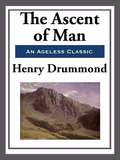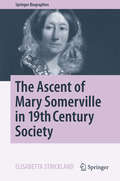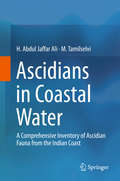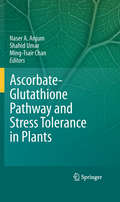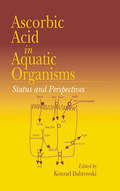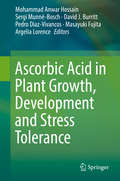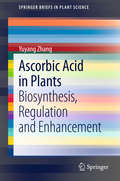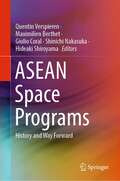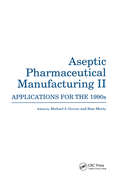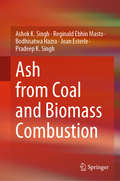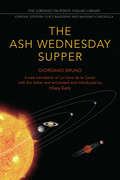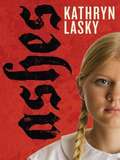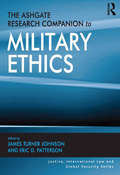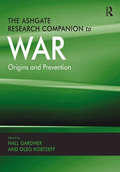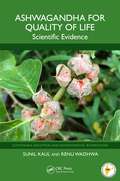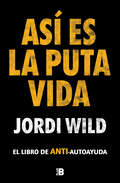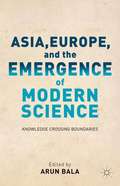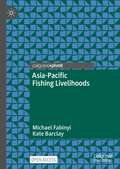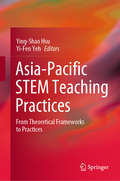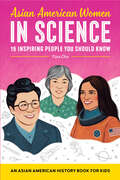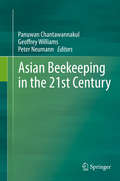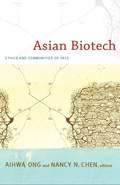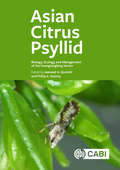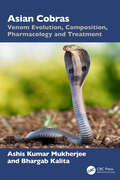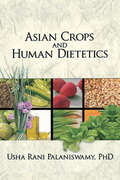- Table View
- List View
The Ascent of Man
by Henry DrummondIn the Ascent of Man, Henry Drummond gives his take on Evolution. He sees evolution as divinely guided-- a position that made him no friends on either side of the debate. "'The greatest thing a human soul ever does in this world is to see something, and tell what it saw in a plain way.' In these pages an attempt is made to tell 'in a plain way' a few of the things which Science is now seeing with regard to the Ascent of Man. Whether these seeings are there at all is another matter. But, even if visions, every thinking mind, through whatever medium, should look at them. What Science has to say about himself is of transcendent interest to Man, and the practical bearings of this theme are coming to be more vital than any on the field of knowledge. The thread which binds the facts is, it is true, but a hypothesis. As the theory, nevertheless, with which at present all scientific work is being done, it is assumed in every page that follows."
The Ascent of Mary Somerville in 19th Century Society
by Elisabetta StricklandThis biography traces the life and work of Mary Fairfax Somerville, whose extraordinary mathematical talent only came to light through fortuitous circumstances. Barely taught to read and write as a child, all the science she learned and mastered was self taught. In this delightful narrative the author takes up the challenge of discovering how Somerville came to be one of the most outstanding British women scientists and, furthermore, a popular writer. Particular attention is paid to the gender aspects of Somerville's success in what was, to put it mildly, a predominantly male domain.
Ascidians in Coastal Water: A Comprehensive Inventory of Ascidian Fauna from the Indian Coast (SpringerBriefs in Animal Sciences)
by H. Abdul Jaffar Ali M. TamilselviThis book addresses the needs of professional and amateurtaxonomists on the subject of ascidians in Asia. This is the first book of itskind and features color illustrations done by the authors in Asia. This bookprovides a brief overview of ascidians in addition to both the taxonomy anddistribution of ascidians along India's southern coast. It also opens a newarena for marine researchers in the field of ascidians in Asia. This book isthe outcome of the authors' 15 years of research experience in the field ofascidians, making it very helpful for researchers, coastal planners, portauthorities and the proper management of coastal thermal plants and atomicpower plants.
Ascorbate-Glutathione Pathway and Stress Tolerance in Plants
by Shahid Umar Naser A. Anjum Ming-Tsair ChanPlants are sessile organisms that live under a constant barrage of biotic and abiotic insults. Both biotic and abiotic stress factors have been shown to affect various aspects of plant system including the acceleration in the formation of reactive oxygen species (ROS). The ascorbate (AsA)-glutathione (GSH) pathway is a key part of the network of reactions involving enzymes and metabolites with redox properties for the detoxification of ROS, and thus to avert the ROS-accrued oxidative damage in plants. The present book mainly deals with the information gained through the cross-talks and inter-relationship studies on the physiological, biochemical and molecular aspects of the cumulative response of various components of AsA-GSH pathway to stress factors and their significance in plant stress tolerance.
Ascorbic Acid In Aquatic Organisms: Status and Perspectives
by Konrad DabrowskiWe are just beginning to discover the importance of vitamin C in the health of natural and man-made ecosystems. Synthesis of ascorbic acid is well understood, but algae as the only source of ascorbate in the aquatic food pyramid has not been explored. There is an expanding field of the culture of aquatic organisms that demand formulated feeds to be
Ascorbic Acid in Plant Growth, Development and Stress Tolerance
by Argelia Lorence Masayuki Fujita Mohammad Anwar Hossain Pedro Diaz-Vivancos Sergi Munné-Bosch David J. BurrittLatest research on ascorbate metabolism in plants.<P><P> Contributed by an international panel of experts.<P> Comprehensive review on antioxidant pathways and physiology for plant funtions.<P> Ascorbic acid (AsA), vitamin C, is one of the most abundant water-soluble antioxidant in plants and animals. In plants AsA serves as a major redox buffer and regulates various physiological processes controlling growth, development, and stress tolerance. Recent studies on AsA homeostasis have broadened our understanding of these physiological events. At the mechanistic level, AsA has been shown to participate in numerous metabolic and cell signaling processes, and the dynamic relationship between AsA and reactive oxygen species (ROS) has been well documented. Being a major component of the ascorbate-glutathione (AsA-GSH) cycle, AsA helps to modulate oxidative stress in plants by controlling ROS detoxification alone and in co-operation with glutathione. In contrast to the single pathway responsible for AsA biosynthesis in animals, plants utilize multiple pathways to synthesize AsA, perhaps reflecting the importance of this molecule to plant health. Any fluctuations, increases or decreases, in cellular AsA levels can have profound effects on plant growth and development, as AsA is associated with the regulation of the cell cycle, redox signaling, enzyme function and defense gene expression. Although there has been significant progress made investigating the multiple roles AsA plays in stress tolerance, many aspects of AsA-mediated physiological responses require additional research if AsA metabolism is to be manipulated to enhance stress-tolerance. This book summarizes the roles of AsA that are directly or indirectly involved in the metabolic processes and physiological functions of plants. Key topics include AsA biosynthesis and metabolism, compartmentation and transport, AsA-mediated ROS detoxification, as well as AsA signaling functions in plant growth, development and responses to environmental stresses. The main objective of this volume is therefore to supply comprehensive and up-to-date information for students, scholars and scientists interested in or currently engaged in AsA research.
Ascorbic Acid in Plants: Biosynthesis, Regulation and Enhancement (SpringerBriefs in Plant Science)
by Yuyang ZhangAscorbate acid (AsA) is an important antioxidant in plants, playing important roles in various physiological processes. Humans have lost the ability to synthesize AsA because of the lack of L-gulono-1,4-lactone oxidoreductase, and thus have to absorb ascorbate from diet including fresh fruits and vegetables, as they are the major sources of ascorbate. Several pathways for AsA biosynthesis and metabolism have been identified in plants since 1998. More attention has been paid to improving ascorbate content in plants especially in fruits and vegetables. Significant progresses have been made on key enzymes and genes involved in the AsA biosynthesis and metabolism. Recently, more interests have arised in the regulation of AsA biosynthesis, as it is constantly regulated by the plant development and the environmental factors, e.g. light. Ascorbic acid is also frequently reported to affect plant growth and development e.g. flowering time and fruit ripening. The scope of the book is to cover the biological role, biosynthesis and metabolism, regulation, and metabolic modification of ascorbate in plants.
ASEAN Space Programs: History and Way Forward
by Hideaki Shiroyama Quentin Verspieren Maximilien Berthet Giulio Coral Shinichi NakasukaThis book presents the first-ever comprehensive analysis of ASEAN space development programs. Written by prominent actors in the region, it goes beyond a mere exposé of the history, current status and future plans of ASEAN space technology development and utilization programs, by analyzing the conditions in which a space program can be initiated in the region. It does so in two ways: on the one hand, it questions the relevance of and motivations behind the inception of space development programs in developing countries, and on the other hand, it focuses on the very specific context of ASEAN (a highly disaster-prone area shaped by unique political alliances with a distinctive geopolitical ecosystem and enormous economic potential, etc.). Last but not least, after having analyzed established and emerging space programs in the region, it provides concrete recommendations for any regional or extra-regional developing nation eager to gain a foothold in space. As such, this book offers a valuable resource for researchers and engineers in the field of space technology, as well as for space agencies and government policymakers.
Aseptic Pharmaceutical Manufacturing II: Applications for the 1990s
by Michael J. Groves; Ram MurtyAsceptic Pharmaceutical Manufacturing II explores the sophisticated technology, developments, and applications that allow aseptic processing to approach the sterility levels achieved with terminal sterilization. Written by experts in sterile manufacturing, this book covers aseptic technology, developments, and applications and makes a valuable contribution to understanding the issues involved in aseptic manufacture. Topics include the processing of biopharmaceuticals, lyophilization, personnel training, radiopharmaceuticals, hydrogen peroxide vapor sterilization, regulatory requirements, validation, and quality systems.
Ash from Coal and Biomass Combustion
by Ashok K. Singh Reginald Ebhin Masto Bodhisatwa Hazra Joan Esterle Pradeep K. SinghThis is a concise book with comprehensive information on coal and biomass ash generated from their combustion in thermal power plants. It presents detailed studies on ash generated from contrasting coal and biomass feedstocks, and provides a comparative evaluation of these different ashes in terms of their origin, properties, environmental hazards. Potential utilizations with specific advantages and disadvantages of the respective ashes are elaborated in detail, including some innovative means of ash utilization for value addition purposes. By addressing both the theory and commercial exploitation of these products, this book will be helpful for industrialists, academicians and researchers alike.
The Ash Wednesday Supper: A New Translation (Lorenzo Da Ponte Italian Library #4)
by Hilary Gatti Massimo Ciavolella/Luigi Ballerini Giordano BrunoGiordano Bruno’s The Ash Wednesday Supper is the first of six philosophical dialogues in Italian that he wrote and published in London between 1584 and 1585. It presents a revolutionary cosmology founded on the new Copernican astronomy that Bruno extends to infinite dimensions, filling it with an endless number of planetary systems. As well as opening up the traditional closed universe and reducing earth to a tiny speck in an overwhelmingly immense cosmos, Bruno offers a lively description of his clash of opinions with the conservative academics and theologians he argued with in Oxford and London. This volume, containing what has recently been claimed as the final version of Bruno’s Ash Wednesday Supper, presents a new translation based on a newly edited text, with critical comment that takes account of the most current discussion of the textual, historical, cosmological and philosophical issues raised in this dialogue. It considers Bruno’s work as a seminal text of the late European renaissance.
Ashes
by Kathryn LaskyBerlin, 1932. Thirteen-year-old Gabriella Schramm's world is slowly, but steadily, crumbling as Adolf Hitler rises to power. <P><P>The only thing that soothes Gabriella is her favorite pastime-reading. <P><P>But then her country's tensions rise, the streets fill with soldiers, Gaby's sister's boyfriend raises his arm in a heil Hitler salute, and a family friend-Albert Einstein-flees the country. <P><P>And her only solace-her books-come under attack. Will Gaby have to leave behind the stories-and the life-that she has always loved?
The Ashgate Research Companion to Military Ethics (Justice, International Law and Global Security)
by James Turner Johnson Eric D. PattersonThis Companion provides scholars and graduates, serving and retired military professionals, members of the diplomatic and policy communities concerned with security affairs and legal professionals who deal with military law and with international law on armed conflicts, with a comprehensive and authoritative state-of-the-art review of current research in the area of military ethics. Topics in this volume reflect both perennial and pressing contemporary issues in the ethics of the use of military force and are written by established professionals and respected commentators. Subjects are organized by three major perspectives on the use of military force: the decision whether to use military force in a given context, the matter of right conduct in the use of such force, and ethical responsibilities beyond the end of an armed conflict. Treatment of issues in each of these sections takes account of both present-day moral challenges and new approaches to these and the historical tradition of just war. Military ethics, as it has developed, has been a particularly Western concern and this volume reflects that reality. However, in a globalized world, awareness of similarities and differences between Western approaches and those of other major cultures is essential. For this reason the volume concludes with chapters on ethics and war in the Islamic, Chinese, and Indian traditions, with the aim of integrating reflection on these approaches into the broad consideration of military ethics provided by this volume.
The Ashgate Research Companion to War: Origins and Prevention
by Hall Gardner Oleg KobtzeffMany different social scientists have been challenged by the origins of wars, their immediate causes and the mechanisms leading to the breakdown of peaceful relations. Many have speculated whether conflicts were avoidable and whether alternative policies might have prevented conflict. The Ashgate Research Companion to War provides contributions from a number of theorists and historians with a focus on long term, systemic conflicts. The problèmatique is introduced by the Editors highlighting the need for interdisciplinary approaches to the study of war as a global phenomenon. The following 29 essays provide a comprehensive study guide in four sections: Part I explicates differing theories as to the origins of war under the general concept of 'polemology'. Part II analyzes significant conflicts from the Peloponnesian wars to World War II. Part III examines the ramifications of Cold War and post-Cold War conflict. Part IV looks at long cycles of systemic conflict, and speculates, in part, whether another global war is theoretically possible, and if so, whether it can be averted. This comprehensive volume brings us a much needed analysis of wars throughout the ages, their origins, their consequences, and their relationship to the present. A valuable understanding that is ideal for social scientists from a variety of backgrounds.
Ashwagandha for Quality of Life: Scientific Evidence (Sustainable Industrial and Environmental Bioprocesses)
by Renu Wadhwa Sunil KaulThis book offers a comprehensive overview of the scientific evidence supporting the diverse health benefits of Ashwagandha. Each chapter delves into specific aspects, exploring its effects on stress management, cognitive function, physical performance, immune system support, sleep quality, and hormonal balance. Through an evidence-based approach, the text aims to bridge the gap between traditional wisdom and modern scientific understanding, presenting Ashwagandha as a promising herb for enhancing quality of life. Ashwagandha for Quality of Life: Scientific Evidence begins by highlighting the origin and botanical characteristics of Ashwagandha and explores the wide range of its traditional and modern applications. By identifying the main active compounds and their functions, readers gain insight into the herb's potential physiological effects. Further, the book investigates Ashwagandha's potential for preventing and treating COVID-19. The book is intended for general readership, herbalists, naturopaths, alternative medicine practitioners, and life science/medical students and researchers to gain a comprehensive understanding of Ashwagandha's potential in improving health and well-being, while also emphasizing the importance of quality and chemotyping for optimal benefits.
Así es la puta vida: El libro de ANTI-autoayuda
by Jordi WildEl esperado libro de Jordi Wild, uno de los youtubers más populares de España y creador de The Wild Project, el pódcast más escuchado. Ni eres el centro del universo ni todos tus sueños van a cumplirse. Olvídate de las chorradas de los libros de autoayuda y de los gurús baratos que intentan hacerte creer que «si quieres, puedes»; de los crypto bros que te harán millonario sin trabajar y de los que te dicen que seas tu propio jefe mientras se graban en la piscina de la casa de sus padres. Aquí no encontrarás recetas mágicas ni los cinco pasos que tienes que seguir para SER FELIZ. Eso se lo dejo a los que se quieren aprovechar de ti. En este libro te voy a contar lo que para mí es la vida de verdad, sin edulcorantes ni azúcares añadidos; la jodida (y maravillosa) lucha que tienes que librar cada día para poder disfrutar y realizarte. La vidate dará una buena somanta de hostias, eso es inevitable, pero de ti depende levantarte y seguir guerreando. Vale la pena, te lo aseguro. ASÍ ES LA PUTA VIDA. ESPERO QUE ESTÉS PREPARADO PARA ACEPTARLO.
Asia, Europe, And The Emergence Of Modern Science: Knowledge Crossing Boundaries
by Arun BalaThis volume brings together essays from leading thinkers to examine what role Asian traditions of knowledge played in the rise of modern science in Europe, the implications this has for the epistemology of science, and whether pre-modern Asian traditions can provide resources for advancing scientific knowledge in future.
Asia-Pacific Fishing Livelihoods
by Michael Fabinyi Kate BarclayThis open access book explores fishing livelihoods in the context of the wider contexts in which they are embedded. Drawing on case studies from across the Asia-Pacific region, the book highlights how fishing livelihoods are shaped by globalisation, social relationships and governance. The book concludes by showing how better understanding these relationships can contribute to governance for healthier ecosystems and social wellbeing.This is an open access book.This is an open access book.
Asia-Pacific STEM Teaching Practices: From Theoretical Frameworks to Practices
by Ying-Shao Hsu Yi-Fen YehThis book offers various perspectives on the complex and crosscutting concepts of the science, technology, engineering, and mathematics (STEM) disciplines in the classroom context. Presenting empirical studies, it reveals how researchers in the Asia-Pacific Region planned and implemented STEM education in the classroom. Further, it discusses the assessment of STEM learning to clarify what important elements should be included and how researchers and educators frame and design assessment tools. The book consists of four parts: potential and trends in STEM education; teachers’ practical knowledge for STEM teaching; STEM teaching practices; and assessment of STEM learning. Providing evidence on developing curriculums, implementing instructional practices and educating classroom teachers, it is intended for readers wanting to explore STEM education from multiple perspectives.
Asian American Women in Science: An Asian American History Book for Kids (Biographies for Kids)
by Tina ChoStories of amazing Asian American women who broke barriers in science—for kids ages 8 to 12 Kazue Togasaki was one of the first Japanese American women to become a doctor. Chien-Shiung Wu was a Chinese American physicist who worked on top-secret projects. Isabella Aiona Abbott became an expert on the marine plant life of her native Hawaii. Asian American women are a huge part of scientific discovery, and this collection of biographies for kids explores 15 brilliant women, and how they used their intelligence and determination to overcome challenges and succeed. Open up this Asian American children's book and meet some of the scientists who helped: Pave the way—Find out how people like inventor Alice Min Soo Chun and computer programmer Josephine Jue designed amazing new technology and spent time educating others. Heal the sick—Learn about doctors like Joan Block and Jacqueline Whang-Peng who revolutionized how we treat diseases like hepatitis B and cancer. Explore new worlds—Discover how botanist Roseli Ocampo-Friedmann and mathematician Angelita Castro-Kelly changed the way we think about outer space. Dive into a world of inspiring women with this science-focused entry into Asian American books for kids.
Asian Beekeeping in the 21st Century
by Geoffrey Williams Peter Neumann Panuwan ChantawannakulFrom the perspective of local scientists, this book provides insight into bees and beemanagement of Asia, with a special focus on honey bees.Asia is home to at least nine honey bee species, including the introduced European honeybee, Apis mellifera. Although A. mellifera and the native Asian honey bee, Apis cerana,are the most commonly employed species for commercial beekeeping, the remainingnon-managed native honey bee species have important ecological and economic roleson the continent. Species distributions of most honey bee species overlap in SoutheastAsia, thus promoting the potential for interspecies transmission of pests and parasites,as well as their spread to other parts of the world by human translocation.Losses of managed A. mellifera colonies is of great concern around the world, includingin Asia. Such global colony losses are believed to be caused, in part, by pests andparasites originating from Asia such as the mite Varroa destructor, the microsporidianNosema ceranae, and several bee viruses.Taking advantage of the experience of leading regional bee researchers, this book providesinsight into the current situation of bees and bee management in Asia. Recentintroductions of honey bee parasites of Asian origin to other parts of the world ensuresthat the contents of this book are broadly relevant to bee scientists, researchers, governmentoffi cials, and the general public around the world.
Asian Biotech: Ethics and Communities of Fate
by Aihwa Ong Nancy N. ChenProviding the first overview of Asia's emerging biosciences landscape, this timely and important collection brings together ethnographic case studies on biotech endeavors such as genetically modified foods in China, clinical trials in India, blood collection in Singapore and China, and stem-cell research in Singapore, South Korea, and Taiwan. While biotech policies and projects vary by country, the contributors identify a significant trend toward state entrepreneurialism in biotechnology, and they highlight the ways that political thinking and ethical reasoning are converging around the biosciences. As ascendant nations in a region of postcolonial emergence, with an "uncanny surplus" in population and pandemics, Asian countries treat their populations as sources of opportunity and risk. Biotech enterprises are allied to efforts to overcome past humiliations and restore national identity and political ambition, and they are legitimized as solutions to national anxieties about food supplies, diseases, epidemics, and unknown biological crises in the future. Biotechnological responses to perceived risks stir deep feelings about shared fate, and they crystallize new ethical configurations, often re-inscribing traditional beliefs about ethnicity, nation, and race. As many of the essays in this collection illustrate, state involvement in biotech initiatives is driving the emergence of "biosovereignty," an increasing pressure for state control over biological resources, commercial health products, corporate behavior, and genetic based-identities. Asian Biotech offers much-needed analysis of the interplay among biotechnologies, economic growth, biosecurity, and ethical practices in Asia. Contributors Vincanne Adams Nancy N. Chen Stefan Ecks Kathleen Erwin Phuoc V. Le Jennifer Liu Aihwa Ong Margaret Sleeboom-Faulkner Kaushik Sunder Rajan Wen-Ching Sung Charis Thompson Ara Wilson
Asian Citrus Psyllid: Biology, Ecology and Management of the Huanglongbing Vector
by Sandra A Allan Sidney Altman Antonio Juliano Ayres El-Desouky Ammar George A Beattie Michael J Boyle Liliana Cano Joseph M Cicero Sasha-Kay V Clarke ELIZABETH E GRAFTON-CARDWELL Susan Halbert David G Hall Michelle Heck Chris S Holland Wayne B Hunter Richard W Mankin Greg Mccollum Jackie L Metz Godfrey Miles Marcelo Pedreira Miranda Cesar Monzo Thomson M Paris K S Pelz-Stelinski Barukh Rohde Andres F Sandoval-Mojica Mamoudou Sétamou Robert G Shatters Jr Burton Singer John M TomichAsian citrus psyllid (ACP), Diaphorina citri, is an insect pest which transmits a bacterium, Candidatus Liberibacter asiaticus (CLas), primarily through feeding in newly emergent foliage of citrus trees. This pathogen causes a disease known as Huanglongbing (HLB), or citrus greening, which has become the most debilitating and intractable disease in citrus crops. This book, written by a team of experts on the Asian citrus psyllid, gathers together everything currently known about the biology and ecology of this important pest species, examines the transmission and acquisition processes of the pathogen, and looks at current management practices and their effectiveness. The potential for new, innovative management techniques are also described, along with the economic implications of managing this rapidly establishing disease. This book: Covers all aspects of Asian citrus psyllid biology and ecology for the first time in one place. Examines new, innovative management practices and assesses their effectiveness. Discusses the vector-pathogen relationship in detail. Explains the economics of controlling this devastating pest. This title is essential reading for all researchers involved in the management and control of Asian citrus psyllid, extension agents, and pest management consultants. It will also be of great use to graduate students in applied entomology and related disciplines.
Asian Cobras: Venom Evolution, Composition, Pharmacology and Treatment
by Ashis Kumar Mukherjee Bhargab KalitaThis book comprehensively explores Asian Cobras, covering their evolutionary history, geographic distribution, venom characteristics, pathophysiology of envenomation, and treatment strategies. The introductory chapters focus on venomous snakes, placing particular emphasis on cobras and the substantial impact of snake envenomation in Asia, where it is recognized as a neglected tropical disease. The venom delivery system, including glands, dentition, and fangs, is explored in detail. The book also explores their appearance, behavior, habitat, feeding, and mating habits, along with their geographic distribution across Asia. Further, the chapters examine the venom composition of different cobra species, highlighting the variations within and between species as well as across geographic regions, supported by advanced biochemical and proteomic analyses. The medical consequences of cobra envenomation are examined, focusing on clinical manifestations such as neurotoxicity, cytotoxicity, and other serious complications, while emphasizing the role of venom variability in determining the severity of envenomation.Key Features: Offers an in-depth overview of the evolution, taxonomy, and ecology of Asiatic cobras Explores the variability in cobra venom composition across different species and geographic regions, supported by cutting-edge biochemical, proteomic, and transcriptomic research Highlights the clinical manifestations of cobra envenomation, including neurotoxicity and cytotoxicity, and emphasizes the pathophysiological differences among cobra species Reviews the latest approaches in treating cobra envenomation, including the use of antivenoms and drug therapies Stresses the importance of public education, government initiatives, and NGOs in addressing cobra envenomation as a neglected tropical disease This book is a valuable source for researchers of toxinology, biochemistry, biotechnology, and biomedical sciences.
Asian Crops and Human Dietetics
by Usha R. PalaniswamyGo beyond the nutritional value to discover the lesser known health benefits of certain Asian crops Several foods from the Asian culture that are not well known to other parts of the world have health benefits that stretch beyond mere nutritional value. Asian Crops and Human Dietetics comprehensively reviews the plants and spices in the A
